Pages: << 1 2 3 ...4 ...5 6 7 ...8 ...9 10 11 12 ... 31 >>
03.10.16
ON THE RUN ( LA FUITE)
Warning: "continue" targeting switch is equivalent to "break". Did you mean to use "continue 2"? in /home/bstep754/public_html/blog/inc/plugins/model/_plugins_admin.class.php on line 1467
Aujourd’hui, un collage où j’ai l’impression d’avoir été audacieux. J’ai voulu introduire un élément incongru, dessiné, relativement plat dans un espace profond, tout en donnant du sens à l’ensemble.
Je suis parti de l’idée d’utiliser les figures de la Danse de Matisse qui, par ailleurs, ne sont pas totalement plats. Il y a en effet des ombres dans les têtes par ex. et les lignes suggèrent le volume. Après un découpage aux petits ciseaux j’ai choisi un fond dont ne subsiste pas grand-chose, mais qui évoque les victimes de l’attentat de Nice. Après, les morceaux se sont ajoutés l’un après l’autre jusqu’à ce que le thème se précise : deux mondes, reliés par des gens qui courent en haut de l’image.
Ce que je trouve intéressant, c’est l’apparent désordre dans l’image dans sa partie gauche – en fait on dirait presque l’origine des fuyards, à droite, est plus tranquille que le monde dans lequel ils débarquent, si l’on fait abstraction de ce qui se passe à Alep. Ici, j’ai plutôt pensé à l’hécatombe en Méditerranée, aux traversées périlleuses etc. Mais d’autres associations sont également possibles comme par ex. les images de vie tranquille et l’agitation, le fait d’essayer de surmonter tous les obstacles et l’échec de certains qui tombent en masse, les tenues des hommes et des femmes…
Je vois cette composition assez grande, dans les 4m de long env., l’espace réduit du collage ne lui permet pas de se déployer comme je le voudrais. A toi, spectateur, de faire le travail en imagination.
Today, a collage where I feel I have been bold. I wanted to introduce an incongruous element -drawn, relatively flat - in a deep space, while giving meaning to the whole.
I started from the idea of using the figures of Matisse's Dance, which, moreover, are not completely flat. There are indeed shadows in the heads eg. and lines suggest volume. After cutting out the figures with small scissors I chose a background that does not remain much, but evoking the victims of the attack in Nice. After the pieces were added one by one until the theme became precise: two worlds, connected by people running at the top of the image.
What I find interesting is the apparent disorder in the image on its left side - in fact it's almost like the origin of the fugitives, on the right, is quieter than the world in which they land, if we ignore what is happening in Aleppo. Here I rather thought of the carnage in the Mediterranean, the perilous crossings etc. But other associations are also possible as such: quiet life images and agitation, the fact of trying to overcome all the obstacles and the failure of some falling en masse, the way men and women are dressed ...
I see this as a rather large composition of 4m approx., the reduced space of the collage does not allow it to unfold as I would like. It’s up to you, the viewer, to do the job in imagination.
Form is loading...
02.10.16
Danse de la Mort
Cette image est venue progressivement. Partie d’une pub Chanel, j’ai petit à petit recouvert l’image originelle dont il ne subsiste que des robes blanches et des bouts en vert et rouge. Au début, j’ai voulu « placer » le visage aux incisives géantes qui m’avaient fait penser à une tête de mort (d’où le titre de Danse des morts, mais j’ai bien vu que cette tête était trop importante et qu’elle jurait avec les robes blanches. La petite scène de guerre en haut m’a permis de « tirer » l’image vers l’actualité syrienne. Ce n’est qu’en observant bien l’image, que j’ai vu que cette scène pouvait faire penser à un visage – une sorte de négatif de la tête de mort. Je lui ai donc offert une paire de jambes. Restait cette grande tête noire. Après plusieurs essais, j’ai opté pour de cheveux blancs, ce qui augmente la dominante blanche. Voilà, à quelques détails près, la généalogie de l’image.
C’est une espèce de ballet qui se joue ici pendant une attaque. Le personnage assis est le miroir de tout cela. Je suis tenté de m’identifier à lui, car j’ai vécu les années de guerre en observateur passif. Mais les images se sont gravées dans ma mémoire. La guerre semble ici absurde, incompréhensible, mais spectaculaire. Cette immense tête semble jaillir de nulle part, comme un spectre ricanant.
Dance of the Dead
This image came gradually. Part of a Chanel ad, I gradually covered the original image of which there remain only white dresses and red and green tips. At first, I wanted to "place" the face with giant incisors that had made me think of a death's head (hence the title of the Dead dance, but I saw that the head was too large and it clashed with the white robes. The small war scene on the top allowed me to "pull" the image to the Syrian news. Only by observing the image with attention, I discovered that this scene could suggest a face - a sort of a negative of the skull, so I offered him a pair of legs. Remained this great black head. After several tries, I opted for white hair which increases the dominant white. This is, roughly, the genealogy of the image.
It is a kind of ballet that performs during an attack. The seated figure is the mirror of all that. I'm tempted to identify with him because I lived the war years as a passive observer. But the images are engraved in my memory. The war here seems absurd, incomprehensible, but spectacular. This huge head seems to spring as if from nowhere, like a sneering spectrum.
You must be logged in to see the comments. Log in now!
Form is loading...
29.09.16
SPACE
C’est un drôle de collage que celui-ci. Il est vrai que c’est un assemblage de morceaux d’origines et d’époques différentes. Mais laissons là le jeu de références à des œuvres plus ou moins connues pour nous intéresser à la composition et au sens.
Ce qui m’a intéressé ici, c’est le contraste entre la platitude de la pièce peinte et la tridimensionnalité du premier plan et de la tête, créant ainsi une oscillation que je chéris depuis 60 ans au moins. Il en résulte, à mon avis, une grande tension, comme dans une illusion d’optique. Pourquoi ce jeu spatial ? Peut-être parce que cela me donne l’impression d’une image vivante, animée, mais à partir d’éléments immobiles. Je pourrais explorer cet effet tridimensionnel dans des peintures géométriques, mais mon propos est figuratif (depuis que je crée). Je préfère l’obtenir de cette manière.
A regarder ce collage, je trouve que c’est une image pessimiste – une tête penchée devant une fenêtre Mondrian munie de barreaux de prison et une pauvre femme en noir manipulée comme une poupée de chiffon. Un univers clos, domestique, banal, sauf le personnage. Son cerveau est à découvert et on y lit le mot « Schuld », (faute). Cette faute le ronge, mais ne l’empêche pas de continuer à faire du tort. Mais au deuxième coup d’œil, je me dis que cela pourrait être aussi une image de la violence banale dans un intérieur banal – à chacun de se faire son film…
It's a funny collage that one. It is true that it is a blend of chips from different eras and origins. But let us leave the game with references to more or less known art works to take an interest in the composition and meaning.
What interested me here is the contrast between the flatness of the painted room and the three-dimensionality of the first plane and head, creating an oscillation that I have been cherishing for 60 years at least. It provokes, in my opinion, great tension, as in an optical illusion. Why this space game? Perhaps because it gives me the impression of a vivid, animated image, but from immobile elements. I could explore the threedimensional effect in geometric paintings, but my point is figurative (since I created). I prefer to get it that way.
Looking at this collage, I think it's a pessimistic picture – an inclined head before a Mondrian window with prison bars and a poor woman in black manipulated like a rag doll. A closed universe, domestic, mundane, except for the character. His brain is exposed and it says the word "Schuld" (fault). This fault corrodes him, but does not prevent him from continuing to harm. But at second glance, I thought this could be a picture of the mundane violence in a plain interior - each one can make his own movie here...
You must be logged in to see the comments. Log in now!
Form is loading...
23.09.16
A collage speaks to me
This year, I feel that I do nothing else than collage. At the rate of two a day, I do not have much time to do anything else. Collages accumulate to the point that I have to find new storage space. The positive in this is that I have to make some order, the negative is that I wonder what this amount of collages will become later. I still don’t achieve the supreme detachment taught by the wise, but I have to do something because I don’t want to leave with this question in mind.
What good is all this? Why this frenzy?
The simplest explanation is this: as I had to work for a living, I catch up now.
But that’s not satisfying. There is something else. Maybe my collage can tell me that. Let's take a closer look:
- Dear collage 482/16 humorously titled "Promettez"*, what is the secret of my obsession to assemble bits of images?
- You got a gift, you have to make it grow.
- Okay, but at this rate, is it necessary?
- I think there are many questions that are running through your head. This seems to be a way to view them.
- You think of M’s cancer?
- Yes, among others. And also of your own mortality, your new physical impairments, such as very short dizziness, your soreness after gardening, your skin becoming so fragile that you wear still the mark of January’s catheter, not to mention light tone tinnitus. Do you want me to quote some more?
- No, thanks, that's enough for now. You mean I feel my death coming closer and that this moves me inside?
- Yes, of course. Moreover, you wonder how to express your relationship to the outside world, how define yourself by it. You're probably relatively unsuitable, you have always preferred dream to reality.
- If I understand you well, I take refuge in my daydreams?
- Yes that's right. But you have the right to rest a little. Fear not, your imagination will not dry up (it's over).
- I thank you and I will try to do as you think.
· = Prométhée in French = Prometheus
Cette année, j’ai l’impression de ne faire que du collage. Au rythme de 2 par jour, il ne me reste pas beaucoup de temps pour faire autre chose. Et les collages s’accumulent, au point que je dois trouver de nouveaux espaces de stockage. Le positif dans cela, c’est que je suis obligé de faire de l’ordre, le négatif, c’est que je me demande ce que cette quantité de collages va devenir. Je n’arrive pas encore au suprême détachement enseigné par les sages, mais il faudra que je m’y mette pour ne pas partir avec cette question à l’esprit.
A quoi bon tout cela ? Pourquoi cette frénésie ?
L’explication la plus simple est la suivante : comme j’ai dû travailler pour gagner ma vie, je me rattrape maintenant.
Mais j’ai de la peine à m’en satisfaire. Il y a autre chose. Peut-être que mon collage peut me renseigner là-dessus. Voyons cela de plus près :
- Cher collage 482/16 intitulée humoristiquement « Promettez », quel est donc le secret de mon obsession à assembler des bouts d’images ?
- Tu as reçu un don, tu dois le faire fructifier.
- D’accord, mais à ce rythme, est-ce nécessaire ?
- Je crois qu’il y a beaucoup de questions qui se bousculent dans ta tête. Cela semble être une manière de les visualiser.
- Tu penses au cancer de M. ?
- Oui, entre autres. Et aussi à ta propre mortalité, à tes nouvelles déficiences physiques, comme par exemple des vertiges très brefs, tes courbatures après le jardinage, ta peau devenue si fragile que tu portes encore la marque du cathéter de janvier, sans parler de ton léger acouphène. Tu veux que je t’en cite d’autres ?
- Non, de grâce, cela me suffit pour le moment. Tu veux dire que je sens ma mort se rapprocher et que cela me remue intérieurement ?
- Oui, bien sûr. Par ailleurs, tu te demandes comment exprimer ton rapport au monde extérieur, comment tu te définis par lui. Tu es sans doute relativement inadapté, tu as toujours préféré le rêve à la réalité.
- Si je te comprends bien, je me réfugie dans mes rêves éveillés ?
- Oui, c’est cela. Mais tu as le droit de te reposer un peu. N’aie pas peur, ton imagination ne va pas se tarir (c’est du passé).
- Je te remercie et je tâcherai de faire selon ton avis.
You must be logged in to see the comments. Log in now!
Form is loading...
01.09.16
A collaged kiss
The collage is like a kiss: the meeting of two foreign elements that must, however, have affinities. It is thus not the die-cuts which make a collage, but their assembly. This could be tedious and not very creative, like a rhyme like "night - right," but it is to create surprises, so the unexpected. It is not for nothing, it seems, that Herta Müller, the great writer of German language - agglutinative language par excellence, thus "agglutinative" - whose compound words are very surprising, also creates collages. To do this, simply combine the elements as the famous surrealist definition of the chance encounter on a dissecting-table of a sewing-machine and an umbrella, while seeking an overall sense of the resulting image, in order to avoid scattering the meanings.
Collage 439/16 is typical for my current research to create a "cubist" space where different elements have their own space and dimension, while remaining interconnected. There is no logical justification for the passage between the relatively flat brown background and space dug behind the robot. The separation is clear, arbitrary, like a spontaneous cut of scissors. Yet, the image seems likely.
No 435/16 is the most extreme in this regard, as it opposes color and black and white, clear and fuzzy, full and empty, untouched and open. No. 408/16 marks a significant step in this research.
To return to the kiss (no. 420/16), it sums up my artistic concerns of the moment. Don’t we say in French that one "embraces" a career? That's how I see my relationship with the collage anyway.
Le collage, c’est comme un baiser : la rencontre de deux éléments étrangers qui doivent cependant présenter des affinités. Ce n’est donc pas le découpage des formes qui fait le collage, mais leur assemblage. Cela pourrait être fastidieux et peu créatif, à la manière d’une rime du genre « amour – toujours », mais il s’agit de créer des surprises, donc de l’inattendu. Ce n’est pas pour rien, il me semble, que Herta Müller, la grande auteure de langue allemande – langue agglutinante par excellence, donc « colleuse » - dont les mots composés sont surprenants, crée aussi des collages. Pour cela, il suffit d’associer les éléments - selon la célèbre définition surréaliste de la rencontre fortuite sur une table de dissection d' une machine à coudre et d' un parapluie - , tout en cherchant un sens global à l’image résultante, pour ne pas éparpiller les significations.
Le collage 439/16 (French robot) est typique de mon actuelle recherche qui vise à créer un espace « cubiste » où les différents éléments ont leur propre dimension et espace, tout en restant interconnectés. Il n’y a pas de justification logique du passage entre le fond brun relativement plat et l’espace creusé derrière le robot. La séparation est nette, arbitraire, comme un coup de ciseaux spontané. Et pourtant, l’image me paraît vraisemblable.
Le no 435/16 (Getting enhanced) est plus extrême à cet égard, vu qu’il oppose couleur et noir et blanc, net et flou, plein et creux, intact et ouvert. Le no. 408/16 (Open mind) marque une étape dans cette recherche.
Pour revenir au baiser (no. 420/16, Royal kiss), il résume bien mes préoccupations artistiques du moment. Ne dit-on pas en français qu’on « embrasse » une carrière ? C’est comme cela que je vois ma relation avec le collage en tout cas.
You must be logged in to see the comments. Log in now!
Form is loading...
10.08.16
Black milk
Patchwork
Must we always explain our creations? I have little time or inclination to do so, except when it becomes urgent.
Here is a confused looking collage at first view because it uses Dali's technique of hallucination as a double view. In this image, a peaceful family is seen in the lower part which extends to the oversized character of the top. It is a Black and whose crying disturbs this idyllic scene. It is obviously an evocation of slavery: Whites are idle, they enjoy their comfortable situation. With one exception: the milking of the cow in the lower left corner, referring to the serfs?
By adopting a different point of view, it could be the nostalgic contemplation of a mythical past (the good old days), where man was supposed to live in harmony with the earth. It is true that many paintings of Poussin, Constable or the Impressionists have cultivated this fable.
What I consciously expressed in this picture is the ratio between stability and instability. The figure of the Black appeared to me towards the end, when I asked myself what was missing in the picture. And the head in profile, like that of the man sitting, could then be the close up of this man whose head is only partially visible, as if hovering above this idyll in the manner of a spirit. As for the milk, it makes me to think of Paul Celan: "Black milk of dawn ..." in his Death Fuge. Et in Arcadia ego ... to stay with Poussin.
Faut-il toujours expliquer ses créations ? Je n'en ai guère le temps ni l'envie, sauf quand cela s'impose à moi.
Voici donc un collage à priori confus car empruntant la technique dalinienne de l'hallucination sous forme de double vue. Dans cette image, on voit une paisible famille dans la partie inférieure dont certaines parties prolongent le personnage surdimensionné de la partie supérieure. C'est un Noir qui pleure et qui perturbe cette scène idyllique. Il s'agit évidemment d'une évocation de l'esclavage : les Blancs sont oisifs, ils jouissent de leur situation confortable. A une exception près : la traite de la vache dans le coin inférieur gauche, allusion aux serfs ?
En adoptant un autre point de vue, il pourrait s'agir de la contemplation nostalgique d'un passé mythifié (le bon vieux temps), où l'homme était censé vivre en harmonie avec la terre. Il est vrai que bien des peintures, de Poussin à Constable, voire les Impressionnistes ont cultivé cette fable.
Ce que j'ai consciemment exprimé dans cette image, c'est le rapport entre stabilité et instabilité. La figure du Noir ne m'est apparue que vers la fin, lorsque je me suis demandé ce qui manquait. Et cette tête, de profil, comme celle de l'homme assis, pourrait alors être le gros plan sur cet homme dont la tête n'est que partiellement visible, comme s'il planait au-dessus de cette idylle à la manière d'un esprit. Quant au lait, il me fait penser au vers de Paul Celan : « Lait noir de l'aube... » dans sa Fuge de mort. Et in Arcadia ego... pour rester avec Poussin.
You must be logged in to see the comments. Log in now!
Form is loading...
09.08.16
In the garden of art
I feel like a gardener who looks after the tradition of painting and without chemistry! And sometimes weed insinuate themselves among the flowers – for the better!
So this collage based on a Van Gogh painting. The gardener is very old because he embodies the long history of painting and this before an impressionistic background. Behind him, a Malevich peasant stands as a reminder of the quarrel between figuration and abstraction, the latter pretending to be progressive, consistent with modernity and revolution. There have been anathema against figurative art. This art has been banned from exhibitions in the 50-60ies, but fortunately this wall of oppression has not kept! Because what counts in my opinion, is the joy of creating freely and to circumvent rules and dogmas. Accept them means to restrict oneself. It is like obeying a diffuse authority consisting of some "experts". I doubt that submission is an artistic value in any field of art . To me it looks like a French garden, made without fantasy and giving the impression of sterility. And it hardly calls for the enjoyment of the premises, evidenced by the rooms devoted to conceptual art!
In my garden I'm trying to experiment with new associations while drawing inspiration from past successes and inviting the visitor to a fun and rewarding walk. Besides, my gardener turns both to the past and the future of art.
Je me sens comme un jardinier qui soigne la tradition de la peinture et cela sans chimie ! Et il arrive que de mauvaises herbes s'insinuent parmi les fleurs – tant mieux !
Ainsi ce collage parti d'un tableau de Van Gogh. Ce jardinier est très vieux, car il incarne la longue histoire de la peinture et ce devant un fond impressionniste. Derrière lui, une paysanne de Malevitch comme rappel de la querelle entre figuration et abstraction, cette dernière se voulant progressiste, en accord avec la modernité et la révolution. Il y a eu des anathèmes contre l'art figuratif. Cet art a été mis au ban des expositions durant les années 50-60, mais heureusement, cette chape de plomb n'a pas tenu ! Car ce qui compte, à mon avis, c'est la joie de créer en toute liberté et de contourner les règles, les dogmes. Les accepter, c'est se restreindre. C'est obéir à une autorité diffuse composée de quelques « experts ». Je doute fort que la soumission soit une valeur artistique dans quelque domaine de l'art que ce soit. Pour moi, cela ressemblerait à un jardin à la française, fait sans fantaisie et donnant l'impression de stérilité. Et cela n'invite guère à la jouissance des lieux, en témoignent les salles consacrées à l'art conceptuel !
Dans mon jardin à moi, j'essaie d'expérimenter de nouvelles associations tout en m'inspirant des réussites passées et en invitant le visiteur à une promenade ludique et enrichissante. Du reste, mon jardinier est tourné à la fois vers le passé et vers le futur de l’art.
You must be logged in to see the comments. Log in now!
Form is loading...
18.06.16
On death
No, my art will not please to enthuse the crowds. This takes away the desire to always create new experiences for the public. My joy to experience is stronger than all that.
Thus the no. 290. Starting with a mummified saint, I had the idea to paste a huge hand holding a sprig of wheat. Then I played with the idea of entering a woman's leg in this hand, but without the visual effect that satisfies me. It is by seeing by chance a picture of nuns that I took the magazine to fall on the image I needed. I naturally thought of my stay in Oberstdorf/Bavaria in 1946, a children's home run by religious Dutch Protestant nuns, and my recent stay at the Geneva hospital. Moreover, I thought of a friend, P., whose health is so desperate that I evoked his death in myself. And finally, this image also reminds my brother, who died last December and who, during the various manipulations done by other persons, threw me mocking looks like the death in this collage. There the gesture of the nun seems positive, in contrast to my own experiences. It is here only a removing of dust or putting a glaze as if it were a good cake. The dead is half hidden by the woman sending his amused gaze at the audience. That reconciles me a bit with the idea of inevitable death - that of my family like mine: I have already exceeded my 75 years of almost five months and I'm at a race against time to build my work.
Another aspect of this concern is in the No. 281, which provides a tranquil and spiritual image of death. It is the passage that I wanted to express, but without melodrama, in a very sober way, thinking of the Buddhist masters, of transformation, although personally I am no believer. It is a soothing and comforting representation that masks the violence of death.
Non, mon art ne plaira pas au point d’enthousiasmer les foules. Cela m’enlève le souci de créer toujours de nouvelles sensations pour le public. Ma joie d’expérimenter est plus forte que tout cela.
Ainsi le no. 290. Parti d’un saint momifié, j’ai eu l’idée de le munir d’une immense main tenant un brin de blé. J’ai ensuite joué avec l’idée de faire saisir une jambe de femme par cette main, mais sans effet visuel qui me satisfasse. C’est en voyant par hasard une photo de bonnes sœurs que j’ai saisi le magazine pour tomber enfin sur l’image qu’il me fallait. J’ai évidemment pensé à mon séjour à Oberstdorf (Bavière) en 1946, home pour enfants tenu par des religieuses protestantes hollandaises, ainsi qu’à mon séjour récent à l’hôpital de Genève. Par ailleurs, j’ai pensé à un ami, P., dont l’état de santé est si désespéré que j’ai évoqué sa mort en moi-même. Et enfin, cette image évoque aussi mon frère, décédé en décembre dernier et qui, pendant les différentes manipulations de tierces personnes, me lançait des regards moqueurs comme le mort dans ce collage. Là, le geste de la religieuse me semble positif, contrairement à mes propres expériences. Il n’est ici qu’un dépoussiérage voire un glaçage comme s’il s’agissait d’une bonne brioche. Le mort étant à moitié caché par la femme envoie son regard amusé au spectateur. Voilà qui me réconcilie un peu avec l’idée de la mort inéluctable – celle de mes proches comme la mienne : j’ai déjà dépassé mes 75 ans de presque 5 mois et je fais une course contre la montre pour bâtir mon œuvre.
Un autre aspect de cette préoccupation se trouve dans le no 281, qui donne une image tranquille et plus spirituelle de la mort. C’est le passage que j’ai voulu exprimer, mais sans mélodrame, de manière très sobre, en pensant aux maîtres bouddhistes, à la transformation, même si personnellement, je n’y crois pas. C’est une représentation apaisante et consolante qui masque la violence du décès.
You must be logged in to see the comments. Log in now!
Form is loading...
03.06.16
On collage/Sur le collage
This collage is an ironic illustration of my work. It takes into account only one aspect, cutting out pictures, dismember them. It is indeed quite sadistic, at least in appearance. This is the first step of an assemblage. But in fact, it is precisely the assembly that makes the image, not its destruction. The viewer first sees the motley aspect, an effect that is visible in any badly or randomly arranged collage. It would of course be nice to hide the junctures in order to obtain a unified picture, a traditional image. So there are two extremes: the disjointed picture or the unified image. What to do to escape this dilemma? Personally, I work on the junction which wants to be it in a literal sense, which unifies while showing the radical otherness of each piece put together. Why this research? I think in my first collages I was looking for a feeling, a laugh at a joke, to make my own movies. Now I am confronted with the legacy of the art, especially in painting. Probably because this legacy seems museumified and that it doesn’t inspire any more. The other day in my garden, I said to myself that my wife knew from where she came from, what piece of land, she kept its smell engraved in her. Not me, probably because my hometown was partially erased during the war and we had to go to the countryside, to stay at a peasant’s home with our nanny, my parents with their friends in their property. My only place to me is my name, my origins, not even my mother tongue. I am, that's all, I am not FROM… Thus in art, my origin, that is my work. That's why I work so hard and with such fury. When I imagine that I had to put it in the background during my so-called active life! Now I am at work for almost 11 wonderful years and I was able to regain a foothold in my original garden: my desk.
Ce collage est une illustration ironique de mon travail. Il ne prend en compte qu'un aspect, le fait de découper des images, de les démembrer. C'est en effet assez sadique, du moins en apparence. Il s'agit de la 1e étape d'un montage. Mais en fait, c'est justement l'assemblage qui fait l'image, pas sa destruction. Le spectateur ne voit d'abord que l'aspect hétéroclite, un effet que suscite tout collage mal agencé. Il serait bien entendu tentant de masquer les jointures pour obtenir une image unifiée, un tableau traditionnel. Il y a donc deux extrêmes : l'image désarticulée ou l'image unifiée. Que faire pour échapper à ce dilemme? Personnellement, je travaille sur la jonction qui se veut telle au sens littéral du mot, elle unifie tout en montrant l’altérité radicale de chacun des morceaux joints. Pourquoi cette recherche? Je crois que dans mes premiers collages je recherchais une sensation, un rire devant un gag, bref à me faire mon propre cinéma. Maintenant, je me confronte à l’héritage de l’art, notamment à la peinture. Sans doute parce que cet héritage me semble muséifié et qu’il n’inspire plus. L’autre jour, dans mon jardin, je me disais que ma femme savait d’ où elle venait, de quel bout de terre, qu’elle en gardait l’odeur gravée en elle. Moi pas, sans doute parce que ma ville natale a été en partie rasée pendant la guerre et qu'on a dû aller à la campagne, nous loger chez un paysan avec notre nounou, les parents chez leurs amis dans leur propriété. Mon seul lieu à moi, c’est mon prénom, mes origines, même pas ma langue maternelle. Je suis, c’est tout, pas je suis DE... Ainsi, en art, mon origine, c’est l’œuvre. Voilà pourquoi j'y tiens tant et avec un tel acharnement. Dire que j'ai dû mettre cela au second plan durant ma vie soi-disant active. Maintenant je suis à pied d'œuvre depuis bientôt 11 belles années ou j'ai pu reprendre pied dans mon jardin des origines : ma table de travail.
You must be logged in to see the comments. Log in now!
Form is loading...
05.05.16
Evolution from 2000 to 2016
Today I will write about the evolution of my collages. To do this, I take 2 collages of 2000, visible on www.archives.stephanus.com to compare them to my current production.
The thing that strikes me first is 
the desire to break the pictorial space as in a Cubist composition. The junctions are brutal and do not always agree with the neighboring forms.
Today I’d adjust more the junctions, eg. between in the character of the first plane between light and dark parts, between the two parts of his face that are not "one." Other elements, such as the brown cushion and "flesh" the triangle seem a bit out of purpose here, although I understand the idea of their presence here that is logical from a purely formal cubist point of view but which neglects the narrative logic. If I had to do it again, I would eliminate anyway the flesh triangle and make more explicit the great man with the raised arm. But I have to say that this collage works still pretty good.
A second example. Here, the connections are better in the face and body, but the blond hair seems to have little justification other than to be there because it belongs to the body of the woman whose head was recovered. This collage approaches the torn poster aesthetics, while showing a Cubist assembly.
And today?
As it can be inferred from the above, I have become more attentive to junctions which are for me the essence of collage / montage.
The collage 199/2016 hints to a Cubist aesthetic, but the connections have been "fine-tuned" to obtain a coherent overall effect, without - apparently – disassemble the space of the image. It follows, in my opinion, greater fluidity in the picture, which brings it closer to a baroque or rococo aesthetic. It is said that mature work shows a certain calm, which is the case here, but only formally, because in terms of content, my work has hardly lost its force in 16 years I hope at least, as more formal mastery does not mean to me less force.
Aujourd’hui, je vais écrire sur l’évolution de mes collages. Pour ce faire, je prends 3 collages de l’année 2000, visibles sur www.archives.stephanus.com pour les comparer à ma production actuelle.
La chose qui me frappe en premier lieu, c’est la volonté de faire éclater l’espace pictural comme dans une composition cubiste. Les jonctions sont brutales et ne s’accordent pas toujours avec les formes voisines.
Aujourd’hui, j’ajusterais davantage les jonctions, par ex. entre le personnage du 1er plan, entre partie claire et sombre, entre les deux parties de son visage qui ne font pas « un ». D’autres éléments, comme le coussin brun et le triangle de « chair » me semblent un peu déplacés ici, même si je comprends l’idée de leur présence ici qui relève de la logique cubiste purement formelle mais qui néglige la logique narrative. Si je devais le refaire, j’éliminerais en tous cas ledit triangle et rendrais plus explicite le grand personnage au bras levé. Mais je dois dire que ce collage fonctionne malgré tout plutôt bien.
Un deuxième exemple. Ici, les jonctions se font mieux au niveau du visage et du corps, mais les cheveux blonds ne semblent guère avoir d’autre justification que d’être là parce qu’ils vont avec le corps de la femme dont la tête a été recouverte. Ce collage se rapproche de l’affiche déchirée, tout en montrant une esthétique cubiste.
Et aujourd’hui ? Comme on peut le déduire de ce qui précède, je suis devenu plus attentif aux jonctions qui sont pour moi l’essence du collage/montage.
Le collage 199/2016 relève lui aussi d’une esthétique cubiste, mais les jonctions ont été « peaufinés » afin d’obtenir un effet global cohérent, sans – apparemment - casser l’espace de l’image. Il en résulte, à mon avis, davantage de fluidité dans l’image, ce qui la rapproche d’une esthétique baroque voire rococo. On dit que l’œuvre de la maturité montre un certain apaisement, ce qui est bien le cas ici, mais seulement sur le plan formel, car pour ce qui est du contenu, il n’a guère perdu de sa force en 16 ans, du moins je l’espère, car plus de maîtrise formelle ne signifie pour moi pas moins de force.
You must be logged in to see the comments. Log in now!
Form is loading...
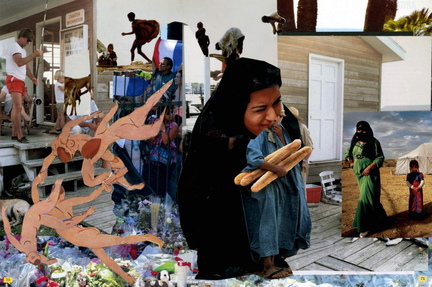
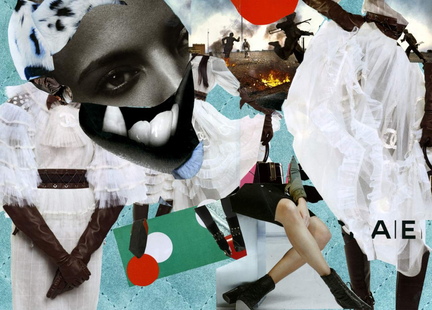
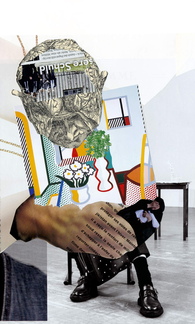
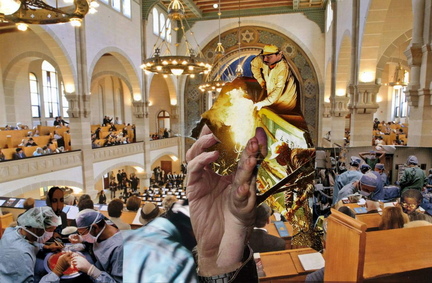
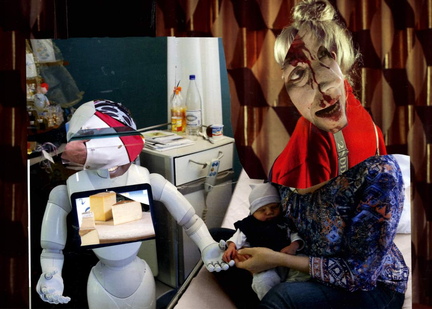
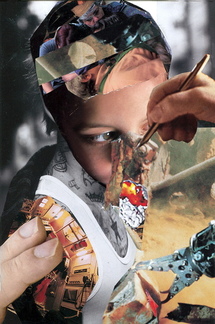
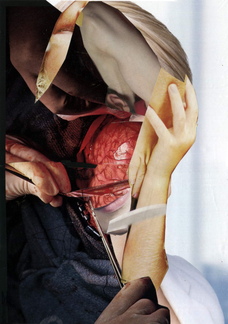
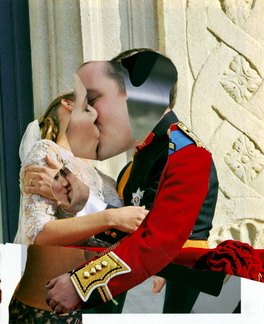
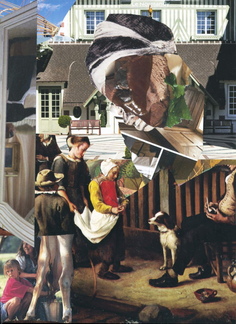
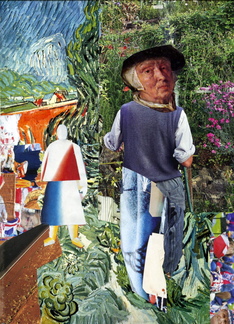
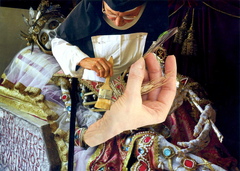
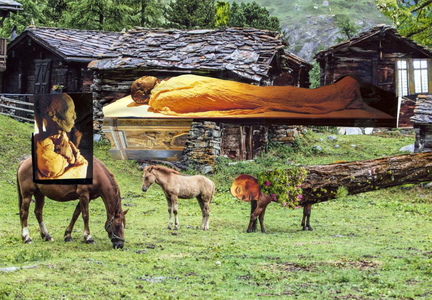
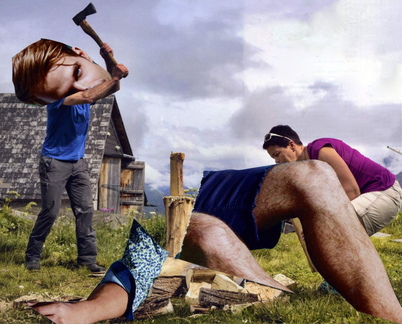


You must be logged in to see the comments. Log in now!